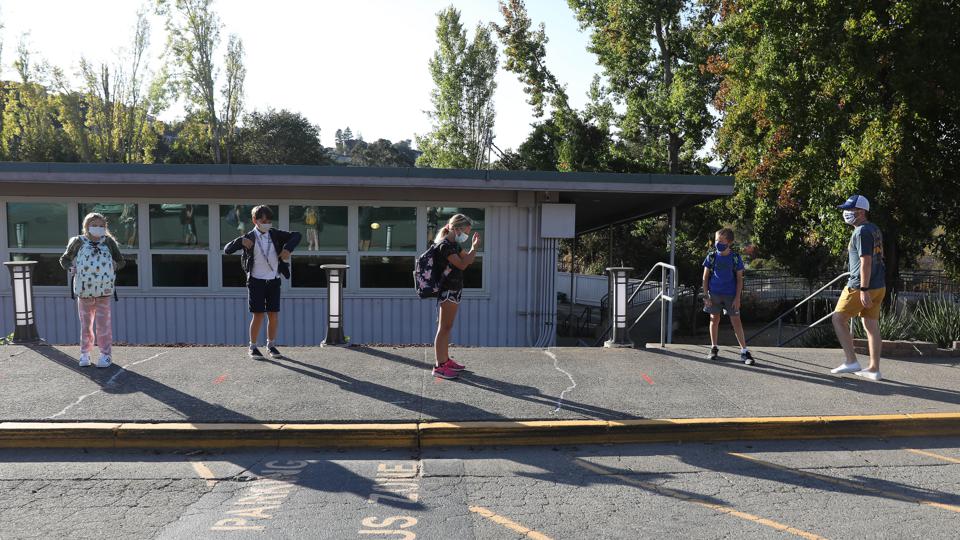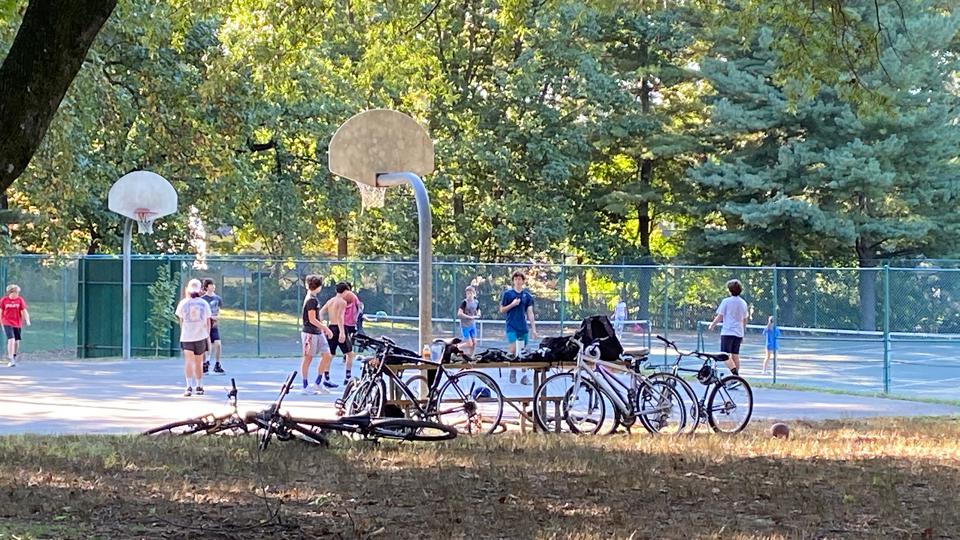As Parents & Teachers Struggle, Public Health Experts Challenge School Mandates

Forbes | October 21, 2020
By Jeanne Allen, Founder and CEO of CER

TIBURON, CA – OCT. 16: Teacher Nathan Grebil (right) leads his fourth grade cohort class to designated hand washing station as they stay socially distant in line at Bel Aire Elementary School on Friday, October 16, 2020 in Tiburon, Calif. as the school reopens from its coronavirus-triggered closure. (Lea Suzuki/The San Francisco Chronicle via Getty Images)
The seriousness of the current education situation cannot be overstated. As frequently discussed here and across the hundreds of news outlets read by most Americans, a majority of students in traditional public schools – and many in charter schools – remain homebound, virtually attempting to learn while their teachers struggle to reach them.
Recently I was in the house with a family member teaching her second grade class in another room. As she began her class noting and welcoming each student she saw, she had to stop to get the attention of more than one person, more than one time.
“Joe (fictitious name) – Joe could you come back to your computer. Joe, can you get away from the TV and come to class? Joe, you are making bad choices…”
Stories like this abound. So do the stories of successful virtual education. But rather than developing responses and policies with data to ensure that every student has the most successful experience they can despite the odds, policymakers have abandoned their duties.
First, they ignore the fact that parents and families have been put in the drivers’ seat and continue to focus on funding public schools that are empty, rather than homes that have become the defacto school for most.
Second, they continue to issue edicts that indefinitely delay school openings, acquiescing to teachers unions and school boards who claim to be wanting to protect adults and students but in effect have no science to back up restricting schools from even small groups of students.
Says Harvard T.H. Chan School of Public Health’s Joseph Allen, “The consequences are devastating. We have virtual dropouts. We have major school districts in the U.S. where a third of the kids are not logging in every day. This spring, right here in Boston, 10,000 high school kids didn’t log in at all in the month of May. Kids are less social, and the learning is different. According to UNICEF, kids in school are less likely to suffer from abuse, neglect, exploitation, and violence. Over 30 million kids rely on schools for nutrition, so there are food-security issues. There’s a risk from COVID, but that can be managed in the classroom.”
He and his colleagues from Harvard confirmed what many of us have argued for months – that making policy based on anecdotes not only fails to help anyone but is bad science. “We need a richer accounting of the costs and benefits of schooling models beyond just virus transmission. Key metrics should include student learning, engagement and well-being. How many students are consistently attending school (either in person or remotely), completing assignments and meeting learning objectives? How many have a stable Internet connection and quiet place to work? How many are missing meals or health-care services they typically receive at school?”
“Cases in school must be reported in context — both in terms of the population size in question (not just case counts) and whether infections were actually transmitted in schools rather than in the broader community.”
This is precisely the point that advocates for major change in how the U.S. education system is run and operates have been making for decades: that not until we have personalized the education process will our nation achieve massive success for every student. But just as the establishment echews thinking outside of uniform, cookie-cutter structures and prefers top-down, contract dominated, zip-code determined schooling, the establishment and those who fear its wrath eschew personalized approaches to whether and how to families can and should be able to educate their children during the pandemic.
The solution for some might be a microschool, but the NEA has put that concept into their “opposition research” category and is trying hard to discredit that kind of learning. The solution for some might be a private school, but the resources for their education are confined to empty buildings. The solution for others might be homeschooling, using tutors, or friends or retired teachers, but that also requires compensation which most parents do not have. Or the solution may be as in states like Florida and Arizona that school districts and charter schools are permitted to open and serve anyone who wants to go, either in person or online.
The solution is not keeping schools closed because anecdotes and emotion are driving decision making. As the researchers from Harvard argue, the view that remote learning is safer “assumes children are at home, safely distancing from others. But policymakers must consider that in many households, parents have to work, meaning children are often in teaching ‘pods,’ nanny shares or group hangouts at local playgrounds. This leads to a series of mixed interactions between children and adults.”

Social distancing, while more strictly enforced in places like school and the mall, has been an inconsistent practice for many kids at play throughout the summer.
I saw this recently first hand at our local park. Groups of dozens of kids without masks were playing all different sports together. Any other time I would have thought it extraordinary, that finally, kids were playing outside together again, away from the house and computers. But this was their escape, not their normal course of business. And they were not at all protected. What’s the difference between this and being well-placed in schools or other environments for formal learning?
Again the Harvard scientists give us a clue to answer that. “Hybrid models and remote learning may not reduce infection risk relative to in-person schooling that requires masks and keeps kids in smaller, contained groups. But we need better data to make that determination.” And we need choices and resources to support education to go to parents, educators, and students, not empty buildings, buses, libraries and community centers. As Education Post and brightbeam CEO Chris Stewart says, “There is no rewind on childhood.”
Follow Jeanne on Twitter or LinkedIn or some of her other work here.
Founded in 1993, the Center for Education Reform aims to expand educational opportunities that lead to improved economic outcomes for all Americans — particularly our youth — ensuring that conditions are ripe for innovation, freedom and flexibility throughout U.S. education.














